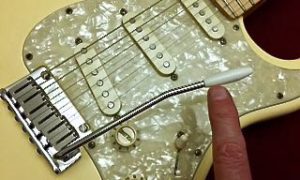Which Guitar Is Best For Me?
What style of music do you like, which guitar does your favorite artist play, and how big are you? These are the essential questions to answer that will help you determine which guitar will work best for you.
If you like blues guitar, consider a Fender Stratocaster. Heavy Metal guitarists often prefer an Ibanez Electric Guitar. Country guitar players will often use a Fender Telecaster for the brightness that guitar has. If you like Latin Rock Guitar, consider a Paul Reed Smith Guitar.
A Taylor, an Alvarez, or a Martin Guitar is what many acoustic artists use. A Les Paul Guitar has long been associated with rock-n-roll. If you like Fingerstyle Jazz, consider a hollow body electric.
All of the above are stereotype recommendations. In other words, these are guitars types that are frequently associated with a specific music genre. Those stereotypes are there for a reason. The reason being that those types of guitars work well in those styles of music. Certainly, you can use any guitar to play any style. There is nothing to say that you can’t use an acoustic guitar to play Heavy Metal. You don’t see it done very often, but there is nothing to prevent you from doing that. You can absolutely use a Fender Stratocaster to play blues, rock, jazz, or whatever.
Each of these guitars will have several “Models”. Each model in contrast, will be similar in body shape, but they will have variations in the quality of the materials used in the construction. An electric guitar might have different brand pick-ups, or a different pick-up configuration. ( one pick-up, two pick-ups, 3 pick-ups, single coil pick-ups, hum bucker pick-ups, etc).
For example, a Fender Stratocaster could be:
*American Original 50”s
*Fender Squier Stratocasted
*American Elite Stratocaster
*American Professional Stratocaster
*Deluxe Roadhouse Stratocaster
*Fat Strat
*…….and more!
Cost will vary depending on where the guitar was built and what materials were used.
What Kind of Guitar Does your Favorite Artist Play?
If you are looking for a particular sound, a good place to start your research is to look at what your favorite guitar player uses. Remember that it is not just the guitar that is creating the sound. There is a whole chain of influences that is helping them get their tone. Everything from the thickness of the guitar pick, the guitar , the strings, the amplifier, the size and type of speakers, the cable, the room, and the player themselves is responsible for getting the tone. The type of guitar they are using is a key factor and a good place to start your search for your new guitar. So, what kind of guitar are they playing? Also, what model is it? Are the pick-ups standard for that guitar? What brand of strings are they using? Do they play the guitar in standard tuning, and if so, what gauge of strings are on the guitar? Have they personally modified the guitar? You can usually find out all of this information on a fan page.
Find the Guitar That Fits Your Size
Finding a guitar that fits your size is usually not a problem. Those people who have the most difficulty finding a guitar that fits are people that are very small in stature, or those people that have exceptionally wide finger tips. I would say that those people with exceptionally wide finger tips have the most difficult time finding a guitar that works for them. I have had a couple of students where the tip of their index finger easily covered two strings, and almost covered the third string as well. A guitar that fits can be found for them by searching for guitars with wide necks, or having a guitar custom built.
Having a guitar custom built is the more expensive route, but you don’t want to be fighting the guitar while you are trying to learn. For most of us, finding a guitar that fits is no problem at all.
What are some Good Name Brand Guitars?
*Fender
*Ibanez
*Gibson
*Paul Reed Smith
*Godin
*Gretsch
*Taylor
*Martin
*Alvarez
What Are The Parts of The Guitar?
The Body, Neck, Head, Tuning Key, Nut, Frets, Face, Bridge, Bridge Pins, Saddle, Sound Hole, and Pick Guard are the primary parts of an acoustic guitar.
The Body, Neck, Head, Nut, String Guide, Tuning Keys, Frets, Face, Bridge, Saddles, Pick-ups, Face Plate, Input Jack, Pick-up selector switch, Volume Knob, and Tone Knob are the main parts of an electric guitar.
The largest part of the guitar is the Body. It is the part, that if you were sitting down, the curve part of the body would rest on your leg. That is the traditional way of holding your guitar.
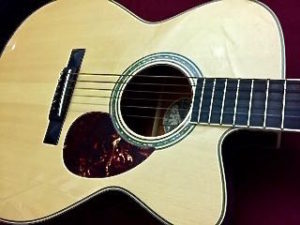
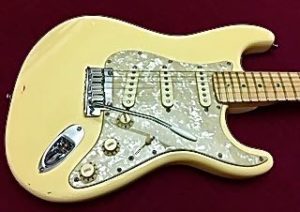
The neck attaches to the body of the guitar and it is measured off by the frets. The frets are the silver pieces of metal that run perpendicular to the neck. The distance between each fret gets larger the further you move away from the body of the guitar.
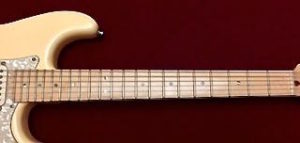
At the end of the neck, the side that does not attach to the body of the guitar, is the head of the guitar. The neck and the head are distinguished as two different parts. The dividing line between the two is the nut.
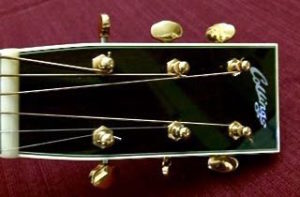
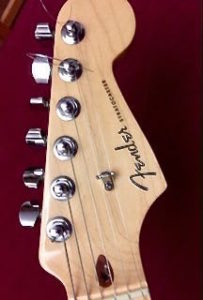
The strings run over the Nut before the strings get wound onto the tuning key. The function of the nut is to slightly elevate the strings above the frets so that the strings don’t touch the frets unless the player presses down on the string. The nut can be made out of carbon, plastic, brass, or bone. Little notches are cut into the top of the nut to help guide and stabilize each string.
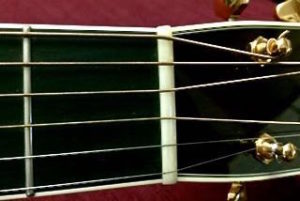
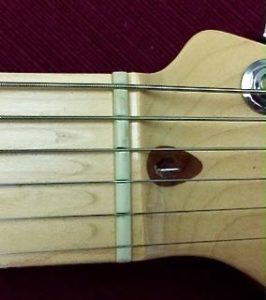
The tuning keys, which are on the head of the guitar, are sometimes referred to as machine heads. They are made up of a post, which the string is wrapped around, and a mechanism that winds the string around the post.
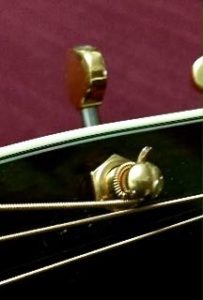
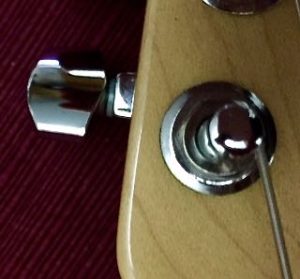
The other end of each string is attached to the bridge. The bridge, on an electric guitar, is a metal plate that is attached to the body of the guitar. On an electric guitar, this can be a fixed bridge or a floating bridge. A floating bridge is still attached to the body of the guitar, but it has a spring system that allows you to use a whammy bar.
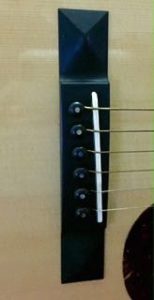
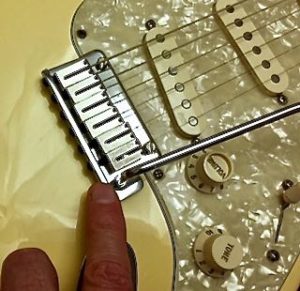
A whammy bar is not on all electric guitars. Some electric guitars have a “fixed” bridge. When you are deciding which guitar is best for you, whether a guitar has a whammy bar with a floating bridge, or whether the guitar has a fixed bridge, is something to consider. The style of music that you are most interested in will help you decide.
The downside of having a whammy bar is that it does make your guitar more difficult to tune. It is also recommended that you have locking machine heads, or some kind of string locking mechanism at the nut if you plan on using the whammy bar. Without the locking system, you will most likely have issues keeping your guitar in tune.
A bridge on an acoustic guitar is made out of a hard wood that is glued to the face of the guitar. The acoustic guitar will have bridge pins which poke through the bridge and secure each string to the guitar.
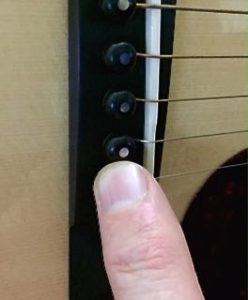
The saddle sits on the bridge. Each string rides across across the saddle befored heading down the fingerboard. The purpose of the saddle is to raise each string above the fret board so that each string is not resting on the frets. So, both the saddle and the nut serve the same function on opposite ends of the length of the string.
On an acoustic guitar, the saddle is one piece. It is made out of bone, plastic, or some other hard material. It has notches cut into it so each string has a groove to stabilize and guide it.
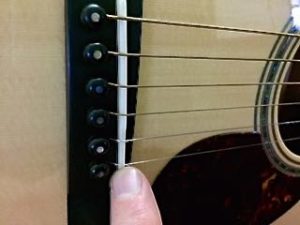
The electric guitar will often have a separate saddle for each string. These saddles can not only raise and lower the height of each string, but they can also change the length of each string. Changing the length of each string has to do with intonation, or rather being able to get the guitar in perfect tune.

The face of the guitar is the front surface of the body of the guitar. In other words, the face is the surface an observer would see as they watch you play guitar. The face can be absolutely gorgeous on either an electric or an acoustic guitar. This is where the price of the guitar can fluctuate as well because it is a piece of art as much as being a musical instrument. Painting, inlays, materials, binding, and craftsmanship all influence price.
A plastic plate found on an electric guitar is called a face plate. The hard plastic found on some acoustic guitars is called a pick guard.
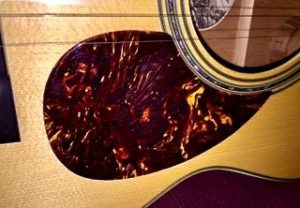
The face plate conceals some of the electronics of the electric guitar. The pick guard on an acoustic guitar keeps your pick from scratching the face.
The sound hole on an acoustic guitar is exactly that. It is a hole on the face of the guitar that the sound is projected out of.
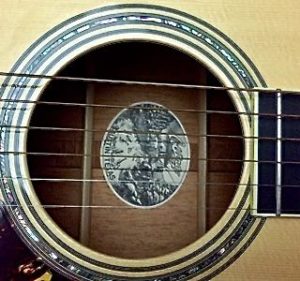
An electric guitar has pick ups. Pick ups set up a magnetic field. Hence, when you strike a guitar string, the vibration of that string interferes with that magnetic field. The interruption is sent through the guitar cable down to your amplifier. That is where the signal is deciphered, amplified, and reproduces the sound through the speakers.
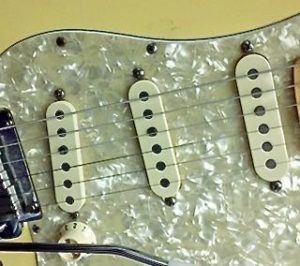
A pick-up selector switch is on the face of the electric guitar. This allows you to switch between which pick-up you want to use. It will usually be either a three position or a five position switch. When the pick-up close to the neck is selected, it will have a more mellow sound than the other pick-ups. It is sometimes referred to as the “rhythm” pick-up. It doesn’t mean that you can’t play lead on that pick-up. Jimi Hendrix used that pick-up quite a bit.
When the bridge pick-up is selected, there is a brighter tone. This pick-up is sometimes referred to as the “lead” pick-up. A lot of players like to use this pick-up because when they use a distortion peddle, the brightness of using the bridge pick-up helps the notes cut through and be more distinct.
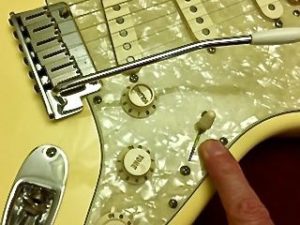
How Many Styles of Acoustic Guitar are There?
*Dreadnaught
*Parlour
*Jumbo
*Auditorium
*Grand Auditorium
*Classical
There are variations on each, but the classification deals with the size and shape of the guitar.

